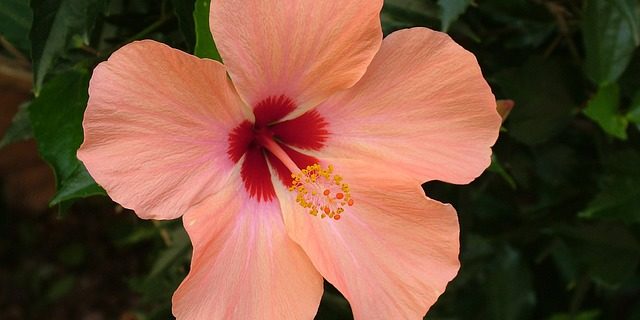Of the hundreds of species of hibiscus in the world, almost all of them originate in hot, tropical climates. In hot-weather cultures the world over, hibiscus is used to cool the body, relieve stress, and mitigate the effects of excessive heat.
Today we will share three summer recipes to bring the cooling beauty of hibiscus into your life. With a batch of hibiscus tea as your base, there’s no end to the delicious blends, soaks, and skin treatments you can create.
Hibiscus’ tart, refreshing flavor makes it an ideal summertime tea. Excess heat in the system is hard on the heart and digestive system, and it can lead to toxic buildups both physically and emotionally. Cooling and astringent herbs are the antidote, and hibiscus fits the profile beautifully.
Hibiscus tea hydrates and cools the body, supports the heart, and gently cleanses the digestive system. It is mildly laxative and diuretic, keeping digestion and elimination flowing smoothly while dislodging the blockages and congestion that excess heat can create. When heat collects in the body, hibiscus encourages dispersal and elimination. It eases swelling and inflammation in the joints and muscles, and its rich vitamin C content and antimicrobial action help ward off summer colds and unfriendly digestive pathogens.
For the more serious symptoms of heat exhaustion, such as loss of appetite and fluid retention, hibiscus has a restorative, normalizing effect. It gently flushes excess fluid from the system and restores the appetite while hydrating, cooling, and supporting the heart.
Hibiscus is often paired with hawthorn for its strengthening effect on the heart. Like hawthorn, hibiscus helps to lower blood pressure and prevent fatty buildup in the arteries. Its astringency supports the venous system as a whole, and its richness in antioxidants protects the heart from the effects of stress. Hibiscus also improves the flavor of hawthorn tea, making it a more palatable, everyday drink, especially in the summertime. On an emotional level, hibiscus calms the nerves and disperses the hot-tempered effects of excess pitta in the mind, encouraging patience, enjoyment, and a greater range of emotional flexibility.
Brew up a batch of hibiscus tea, and you’ve got a tart, beautiful, medicinal beverage that can be enjoyed by itself or as the base for any number of healing teas, blends, and cosmetics. Enjoy!
Hibiscus Summertime Tea
For parties and gatherings, plain hibiscus tea served cold with lime juice and sweetener makes a beautiful beverage with a rich, red color. It’s a great base for summer cocktails and mixes well with most fruit juices. Sweeter juices like grape and bilberry cut the tartness and can substitute as sweeteners, though they will darken the color of the tea.
**For an everyday, medicinal tea to keep you cool, support the heart, and stow in your water bottle, add 1 tablespoon each of Tulsi, Lemon Balm, Hawthorn berries, and Spearmint to the mix. Like the recipe below, the “medicinal version” can be cold-brewed in the fridge overnight.
Serving Size: 1 quart
1/2 cup dried hibiscus flowers
4 cups water
Lime wedges or 1-2 tablespoons lime juice
Sweetener to taste
Place the hibiscus and water in a large jar or bowl, cover, and place in the fridge overnight, or for 8-12 hours.
Strain the tea, stir in the lime juice and sweetener, and enjoy!
Garnish with mint and basil sprigs, if desired.
Healing Hibiscus Bath
Hibiscus is wonderful for the skin. Just as it cools, cleanses, and heals when taken internally, it has the same effect on overheated summer skin. For sunburn, congested pores, or stress relief, this soothing bath will calm the mind and gently cleanse, moisturize, and rejuvenate tired skin.
1 cup dried hibiscus flowers
1/4 cup dried rose petals
1/4 cup lavender flowers
1/4 cup dried peppermint or spearmint
1/4 cup dried calendula
muslin bag or cheesecloth
optional:
1 tablespoon coconut oil
1/2 cup baking soda
1 cup Epsom salt
Gently mix the herbs together in a large mixing bowl. Fill a muslin bag with the mixture, or place the desired amount onto the cheesecloth and tie it shut with a string. You can tie the bag or cheesecloth to the faucet while you run the bath, or you can place it anywhere in the tub to steep in the warm water.
Hibiscus Hair Rinse
Hibiscus stimulates hair growth and is often used in hair conditioners for its ability to bring out highlights in hair, nourish the scalp, and encourage shine and luster. A hibiscus hair rinse provides a refreshing, cooling bath for the head while conditioning the hair, discouraging dandruff, and encouraging growth.
1-2 tablespoons dried hibiscus
16 ounces water
optional: 1 drop sweet basil essential oil
2 drops lavender essential oil
Place the hibiscus in a pot or jar of water, and let it steep overnight. Or, gently warm the hibiscus and water mixture on the stove, not quite bringing it to a boil. Let it cool, covered, until it is comfortable to touch. At this point, you can stir in the essential oils if you are using them.
Massage a few ounces of the rinse into your scalp, rubbing thoroughly. Then, hold your head over a bowl or container, placing the ends of your hair into the bowl. Pour a cup of the infusion over your head and allow it to drain into the container. Repeat this several times, massaging the infusion into your hair and scalp. Rinse with freshwater afterward, if desired.
I hope you will enjoy these recipes and find your own delicious ways to incorporate hibiscus into your summer this year.
Stay cool!








